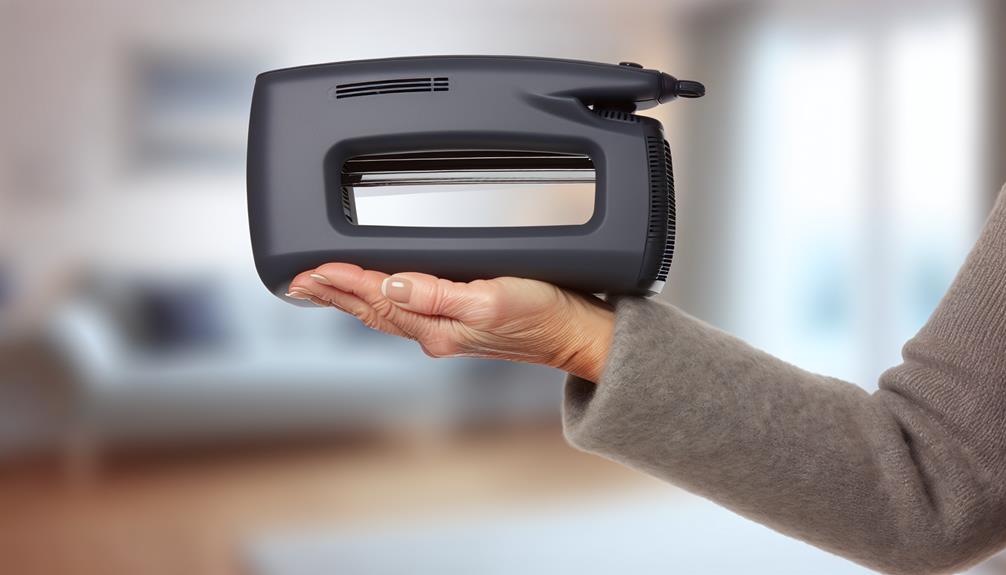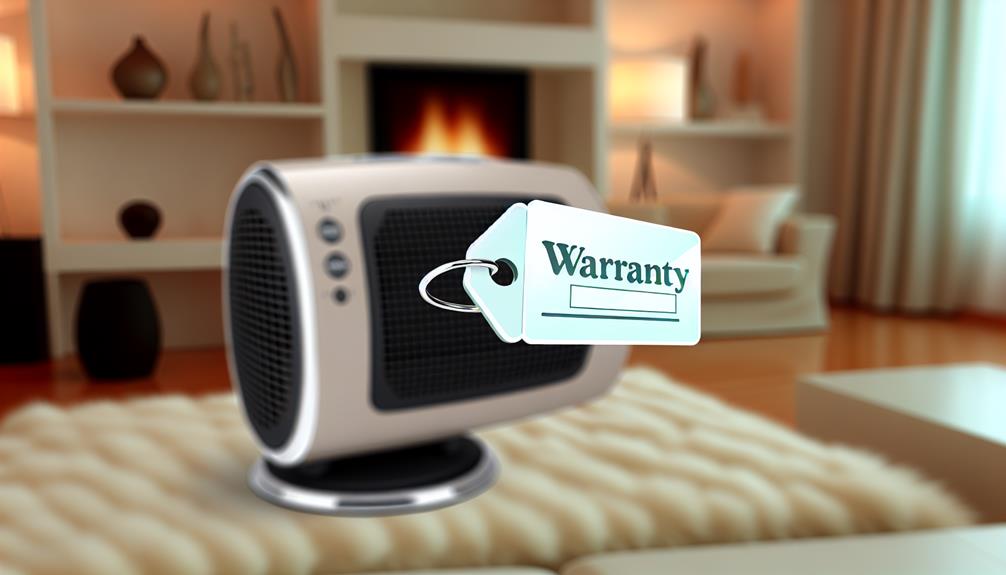As the winter chill creeps into your home, you might find yourself in search of a trusty portable heater, much like a traveler seeking a warm campfire in the cold night. You're not alone; statistics show a surge in portable heater sales as temperatures drop. But before you rush to join the crowd, it's essential to know that not all heaters are created equal. You'll want to consider factors such as the size of the area you need to warm, the type of heater that aligns with your comfort needs, and the safety features that protect your peace of mind. Moreover, with a myriad of models boasting various energy efficiencies and additional functionalities, pinpointing the perfect match for your space can be as nuanced as choosing the right wine to complement your dinner. So, as you stand at this crossroads, pondering which path will lead you to cozy evenings without a shiver, keep in mind that the devil is in the details, and those details could make all the difference in your winter experience.
Key Takeaways
- Consider the room size compatibility and choose a heater with appropriate heating capacity.
- Maximize energy efficiency by looking for heaters with programmable thermostats and timers.
- Prioritize safety features such as overheat protection and tip-over switch.
- Take into account the portability and design of the heater, including factors like weight, compactness, and aesthetics.
Heater Type Varieties
When selecting a portable heater, it's crucial to understand the different types available, each with its own mechanism for heating your space. The types of space heaters you'll encounter include convection heaters, which are known for providing quiet, consistent warmth suitable for entire rooms. These heaters work by circulating warm air using a heating element and are often energy efficient, making them a popular choice.
Infrared heaters, also known as radiant heaters, offer a different approach by directly heating objects and people in their path, delivering quick warmth that's ideal for spot heating. This technology is less about warming the air and more about warming the immediate area surrounding the heater.
Fan-forced heaters leverage a fan to blow air across a heating element, thereby distributing heat more rapidly throughout your space. This type of heater can quickly eliminate cold spots but may produce a bit more noise due to the fan.
For a more permanent solution, wall heaters are installed directly into the wall and are great for consistently under-heated rooms. To select the ideal portable heater, consider the wattage and square footage guidelines provided in space heater buying guides, ensuring that you choose a model that aligns with the size of your area and your heating needs.
Heating Capacity
When selecting a portable heater, you must assess the room size compatibility to ensure you're choosing a unit with the appropriate heating capacity. The wattage and BTU output are critical metrics; they define how effectively a heater can raise the temperature of your specific area. Remember, you'll need about 0.24 BTUs per cubic foot, which translates to a direct conversion for wattage, ensuring that you opt for a heater that meets your space's demands efficiently.
Room Size Compatibility
To ensure your portable heater effectively warms your space, you'll need to match its heating capacity with the room's size, taking into account the necessary temperature rise and the volume of the space in BTUs. Room size compatibility is pivotal; the best space heaters are those with a heating capacity that aligns precisely with the size of the room. It's wise to consult a space heater buying guide, which typically offers sizing recommendations based on wattage and square footage. A heater to keep a whole room cozy will require more BTUs than one designed for a smaller space. Most space heaters available are rated by wattage, which can be converted to BTUs—this figure reflects how well heaters work well in various room sizes.
Wattage and BTU Output
Understanding the relationship between a portable heater's wattage and its BTU output is crucial in determining its heating capacity and ensuring it matches your room's requirements. Wattage and square footage are directly linked; higher wattage typically means more heat for larger areas. However, the type of space heater also impacts efficiency. Convection space heaters heat the air using a fan or natural convection, while models with heating elements provide direct heat.
When buying a space heater, consider the needed temperature rise and the volume of space—these inform the BTU calculation essential for proper sizing. Always ensure your chosen heater can convert BTUs to watts for effective comparison. Consult a space heater buying guide for specific sizing recommendations, ensuring your selection aligns with the wattage and BTU output suitable for your space.
Energy Efficiency

Maximizing energy efficiency in portable heaters not only slashes your utility bills but also reduces your carbon footprint. When you're in the market for a space heater, you'll want to consider models that embody energy efficiency to help you save energy and lower heating costs. Look for heaters with programmable thermostats and timers, which allow for better control over heating and can conserve energy by only operating when needed.
Heaters with an ENERGY STAR rating are certified to be energy-efficient. They typically use less electricity, translating to lower operating costs. Be analytical in comparing the wattage of different heaters as this directly impacts the electric heating costs. A lower wattage generally means less energy consumption, but ensure it's sufficient to warm your intended space.
Safety features such as auto shut-off can indirectly conserve energy by turning the heater off in case you forget. Here's a table comparing key features that affect energy efficiency:
| Feature | Energy Efficiency Impact | Benefit |
|---|---|---|
| Programmable Thermostat | High | Tailors heating to your schedule |
| Auto Shut-off | Medium | Prevents unnecessary heating |
| ENERGY STAR Rating | High | Ensures lower energy use |
Safety Features
Prioritizing safety features in portable heaters guards against common hazards and ensures your peace of mind while keeping warm. Overheat protection is a crucial component that helps prevent overheating, thereby significantly reducing the risk of your heater becoming a fire hazard. Look for models with this feature to ensure that the unit will automatically shut off if it reaches an unsafe temperature.
Additionally, a tip-over switch is vital; it immediately turns the heater off if it's accidentally knocked over, which is particularly important in homes with children or pets. This feature is a strong line of defense against the potential of a fire.
Check for a cool-touch exterior as well, which minimizes the chance of burns upon contact. This is especially pertinent when the heater is located in areas where people frequently pass by. Furthermore, automatic shut-off timers contribute to safe operation by not allowing the heater to run indefinitely.
When it comes to the power cord, remember: Never use an extension cord with a portable heater. Extension cords can overheat and create a fire, particularly when used with high-wattage appliances. Moreover, always place your heater away from flammable materials to avoid any fire risk.
Lastly, seek out heaters that have been certified by recognized testing laboratories, such as Underwriters Laboratories (UL) or the Canadian Standards Association (CSA), which assures compliance with established safety standards.
Portability and Design

When selecting a portable heater, consider models with a lightweight and compact design that facilitate effortless movement and space-saving storage. You'll want to examine the heater's features for portability, like whether they come with wheels or carrying handles, which make it easy to move from room to room.
Aside from portability, the design should also cater to your sense of aesthetics and the practicalities of placement and operation. Some models with fans are designed to sit on the floor, while others might be better suited for tabletops or desks. Oscillation features can also be a significant consideration, as they help distribute heat more evenly throughout your space.
Here's a breakdown that combines analytical detail with expertise for what features to look for:
| Feature | Benefit |
|---|---|
| Lightweight | Easier to carry and reposition |
| Compact | Saves space when not in use |
| Wheels/Handles | Facilitates smooth transition between areas |
| Design Aesthetics | Complements home decor and enhances room appearance |
Keep in mind, a heater that blends in with your home environment and is easy to store will likely be a more satisfying long-term investment. Always prioritize a design that complements your lifestyle and the intended use of the heater.
Additional Functionalities
Beyond basic heating, modern portable heaters offer a range of additional functionalities designed to enhance user convenience and control, such as programmable thermostats and variable heat settings. When selecting a heater, consider these advanced features for a more economical and convenient experience:
- Programmable Thermostat: Set your desired temperature and maintain it without constantly adjusting the heater.
- Multiple Heat Settings: Adjust the wattage based on your heating needs, which can be more energy-efficient.
- Timer with Auto Shut-Off: Control the operation duration, ensuring heaters don't run unnecessarily, adding to safety and cost-saving.
- Portability Features: Look for heaters with wheels and remote controls to easily move and adjust settings from afar.
- Ambient Lighting: Choose models with lighting that can create a cozy atmosphere without compromising the heater's efficiency.
These additional functionalities not only contribute to a more precise control over the heating environment but also help in maintaining better air quality. Heaters with a blower or a fan to circulate the warm air can evenly distribute heat throughout your space. Always prioritize features like overheat protection, which automatically turns the heater off if it gets too hot, ensuring your safety. Remember, the best heaters require a balance between performance and user-friendly features.
Price and Warranty

As you evaluate portable heaters, consider how the price aligns with the warranty period to ensure you're getting a cost-effective solution for your heating needs. When buying a heater, it's essential to weigh both upfront costs against the longevity and support the warranty offers. Heaters are typically a significant investment, so the best space heaters come with a warranty that reflects confidence in their durability.
Delve into the details of the warranty to understand what malfunctions or defects are covered and for how long. A longer warranty may justify a higher price since it suggests the manufacturer stands behind their product. Conversely, a cheap space heater with a brief warranty might signal lower quality and could cost more in the long run due to potential replacements.
Don't overlook customer reviews; they can provide insight into the real-world performance of room heaters and the manufacturer's responsiveness to warranty claims. These reviews are a valuable resource to verify if the heater for your needs has a track record of reliability.
Lastly, inquire about extended warranty options. While there's an additional cost, the extra coverage can be a wise investment for keeping your space warm without unexpected expenses should your heater require repairs after the standard warranty expires.
Frequently Asked Questions
How Do I Choose a Portable Space Heater?
Imagine a cozy nook, warmed to perfection—choosing a portable heater hinges on heating efficiency and even heat distribution. Prioritize safety features and low energy consumption to keep bills down. Seek a whisper-quiet unit with easy maintenance. Heater portability ensures you can move it where needed, while thermostat control offers precision. Don't overlook design aesthetics; it should complement your space. Finally, find a quality heater within your price range for the best value.
What Is the Most Effective Type of Portable Heater?
You're seeking the most effective portable heater, focusing on heater efficiency and energy consumption. Infrared heaters with ceramic elements heat quickly and are efficient. Safety features are crucial; look for auto shut-off and tip-over protection. Compare heating capacity and cost, considering oil-filled radiators for consistent heat. Thermostat accuracy ensures comfort and energy savings. Choose based on your climate's suitability; in colder areas, higher wattage might be necessary.
What Should Be Considered When Using Portable Heaters?
When you're cozying up with a portable heater, remember safety precautions come first. Ensure it's placed well away from curtains, and it's got overheat protection. You'll want a model that whispers quietly, so check those noise levels. Keep energy efficiency in mind; thermostat features save bucks. Don't overlook the cord length for convenience. Always peek at the user manual for maintenance tips, and double-check those warranty terms for peace of mind.
What Size Room Will a 1500 Watt Heater Heat?
You're looking for a heater, and a 1500 watt one can heat a space roughly 150 square feet, considering average room insulation. When selecting, assess the heater's energy efficiency, safety features, and electrical consumption. Proper heater placement enhances heat distribution, while the right temperature settings optimize heating efficiency. Pay attention to noise levels for comfort, and follow maintenance tips to prolong its life. Always prioritize safety and energy efficiency in your choice.
